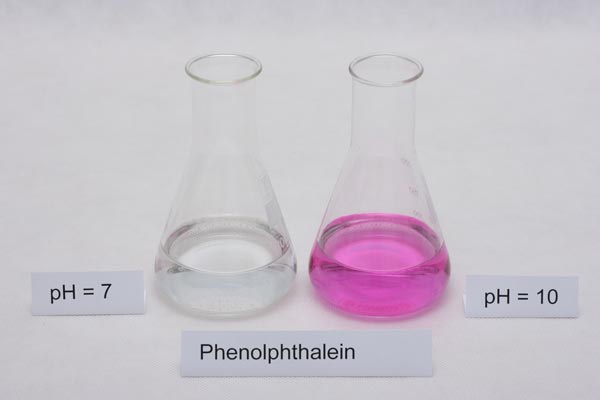As a kid, I was fascinated by magic tricks, especially those involving color changes. I remember watching a magician make a clear liquid turn pink right before my eyes, and I was utterly captivated. Little did I know at the time that the “magic” was based on a chemical compound called phenolphthalein, which could reveal the presence of a hidden base. While it wasn’t a magical potion, it was just as fascinating to me, and it opened my eyes to the wonder of chemistry.

Image: www.pinterest.com
Today, we’ll delve into the world of phenolphthalein and explore the fascinating phenomenon of its color change in the presence of a base. Get ready to unlock the secrets of this chemical indicator, explore its applications, and gain a deeper understanding of how it works.
The Colorful World of Phenolphthalein
Phenolphthalein is a chemical compound that belongs to a class of compounds called **phthaleins**. It’s a weak organic acid, meaning that it doesn’t completely ionize in solution. In its acidic form, it’s colorless. However, the magic happens when phenolphthalein is exposed to a basic solution.
The color change we see is actually a result of structural changes within the phenolphthalein molecule. When phenolphthalein reacts with a base, it undergoes a series of chemical changes that alter the arrangement of its atoms. The key to the color change lies in the formation of a negative charge on the phenolphthalein molecule, which allows it to absorb visible light in the blue and green regions of the spectrum, leaving us to see the complementary color, **pink**, which is what we perceive as the color of the solution.
The Chemistry Behind the Color Change
Let’s break down the chemical reaction that leads to the color change:
Acidic Form
In acidic solutions, phenolphthalein primarily exists in its acidic form, represented by HIn (where In represents the phenolphthalein molecule). This form is colorless.

Image: architecturalstudio.com
Basic Form
When phenolphthalein is added to a basic solution, it reacts with hydroxide ions (OH–) to form a conjugate base, In–. This form is pink. The reaction can be summarized as follows:
HIn (colorless) + OH– → In– (pink) + H2O
This reaction shifts the equilibrium towards the pink colored form, resulting in the visible color change. The intensity of the pink color is directly proportional to the concentration of the base.
The pH Influence
The color change of phenolphthalein is specifically triggered within a certain pH range. It acts as an indicator, changing from colorless to pink within the pH range of 8.2 to 10.0. This specific pH range makes it ideal for titrations involving weak acids and strong bases.
Phenolphthalein: More Than Just a Pink Color
While phenolphthalein is commonly known for its color change in base solutions, it has also found applications in various fields, including:
- Titration: As a pH indicator, phenolphthalein is extensively used in titrations to determine the equivalence point, indicating the completion of a neutralization reaction.
- Medicine: Phenolphthalein was once a common ingredient in laxatives due to its ability to stimulate bowel movements. However, its use as a laxative is now restricted in many countries due to potential health risks.
Beyond the Lab: Real-World Applications
Phenolphthalein has also made its way into some unexpected applications:
- Forensic Science: Phenolphthalein can be used to detect the presence of blood, due to its reaction with the heme found in blood.
- Magic Shows: As I mentioned earlier, the color-changing properties of phenolphthalein have been exploited in magic shows to create illusions and amaze audiences.
Tips and Expert Advice for Understanding Phenolphthalein
Here are some tips and advice based on my experience to help you better understand and work with phenolphthalein:
- Start Small: When conducting experiments with phenolphthalein, experiment with small quantities first. This helps avoid unnecessary waste and allows you to observe the color change more closely.
- Control Variables: Keep in mind that the color change of phenolphthalein is influenced by the concentration of both the base and the indicator. Ensure that you are using consistent concentrations of both to obtain reliable results.
- Safety First: Always handle phenolphthalein with care. It is a chemical and should be used with proper safety precautions, including wearing gloves and eye protection.
FAQ about Phenolphthalein
Let’s answer some common questions about phenolphthalein:
Q: What happens to phenolphthalein in a neutral solution?
A: In a neutral solution, phenolphthalein remains colorless because it exists primarily in its acidic form, HIn.
Q: Can phenolphthalein be used to test for acids?
A: No, phenolphthalein is not an indicator for acids. It only changes color in the presence of bases.
Q: Is phenolphthalein harmful?
A: While phenolphthalein is not considered highly toxic, it can cause irritation to the skin and eyes. Therefore, it is essential to handle it with care and use appropriate safety precautions.
What Color Does Phenolphthalein Turn In A Base
In Conclusion
Phenolphthalein is a remarkable chemical indicator, displaying a dramatic color change in the presence of a base. From its use in scientific labs to its unexpected appearances in magic shows, phenolphthalein continues to fascinate and inform us about the wonders of chemistry. Understanding its properties and its behavior in different pH solutions expands our knowledge of chemical interactions and its applications.
Are you interested in learning more about phenolphthalein or exploring other chemical indicators? Let me know in the comments below, and we can delve deeper into the colorful world of chemistry together!






